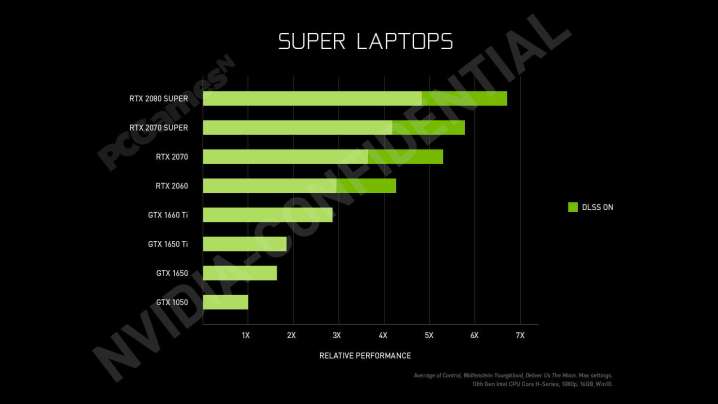A leaked internal slide published on PC Games N reveals some impressive performance increases for Nvidia’s unannounced RTX 2070 Super mobile graphics.
The slid shows that these upcoming cards can deliver approximately 50% better performance when using deep learning super sampling (or DLSS) compared to the vanilla RTX 2070 without DLSS.

Nvidia’s slide shows that the performance improvement is further extended when comparing the more premium RTX 2080 Super model, but the company did not show how the performance of the vanilla RTX 2080 stacks up against these new supercharged GPUs.
One likely reason is that performance of the mobile RTX 2080 and RTX 2080 Super cards may be very similar, and like the desktop RTX Super variants, there may not be much a performance gain between the two 2080 class cards.
The report from PCGames N states suggests that the performance benchmark is an average of results from a mix of games, including Control, Wolfenstein: Youngblood, and Deliver Us The Moon. The games are all running at max 1080p settings. This increase in performance should affect frame rates with both ray tracing on and without.
The publication claimed that the leaked slide was obtained from its anonymous sources, and the performance graph could be part of a release kit that Nvidia is shipping to notebook manufacturers.
If notebook manufacturers are already getting the release kit, a launch could be imminent, and the timing would align with previous rumors of a March release.
Given Nvidia is hosting its own GPU Technology Conference (GTC) next month, the venue could be chosen to unveil the next Super graphics. And unlike the recently leaked Ampere graphics news, the Super cards should be a refresh of Nvidia’s current Turing architecture, delivering better performance and frame rates for enthusiast gamers.
In an earlier leak, German publication Notebook Check published a slide revealing that the RTX 2070 and 2080 Super graphics for laptops will feature 8GB GDDR6 memory and rely on a Max-Q design with 80-watt of thermal design power (TDP). Additionally, the Super mobile GPUs will also benefit from an increase number of CUDA cores.
The Nvidia cards are expected to compete against AMD’s Radeon RX 5500 mobile graphics and Ryzen 4000 APUs. Nvidia will also be facing competition from Intel with its improved Gen11 integrated graphics architecture that debuted on the company’s 10th Gen processors.
The more capable Intel integrated graphics means that casual gamers may no longer need a system with discrete GPUs. Intel’s graphics development could force Nvidia to pivot its strategy to target enthusiasts, creators, and data scientists in the more premium segment.



